|
FAQs on
Goldfish Growths 3
(ex: issues of
lumps, bumps, tumors and growths)
Related Articles: Goldfish
Systems, Goldfish Disease, Goldfish, Goldfish
Varieties, Koi/Pond
Fish Disease, Livestock
Treatment System, Bloaty, Floaty Goldfish,
Gas Bubble
Disease/Emphysematosis, Pond Parasite Control
with DTHP, Hole in
the Side Disease/Furunculosis,
Related FAQs: Lumps/Bumps/Growths 1, Growths 2, Growths 4, Growths 5, Growths 6, Growths 7, & Goldfish Disease 2, Goldfish Disease 3, Goldfish Disease
4, Goldfish Disease 5, Goldfish Disease 6, Goldfish Disease 7,
Goldfish Disease
8, Goldfish Disease 9,
Goldfish Disease
10, Goldfish Disease
11, Goldfish Disease 12, Goldfish Disease 13, Goldfish Disease 14, Goldfish Disease 15, Goldfish Disease 16,
Goldfish Disease
17, Goldfish Disease 18,
Goldfish Disease 19, Goldfish Disease 20, Goldfish Disease 21, Goldfish
Disease 22, Goldfish Health 23, Goldfish Disease 24,
Goldfish Health 25, Goldfish Disease 26, Goldfish Disease 27, Goldfish Disease 28, Goldfish Disease 29, Goldfish Disease 30,
Goldfish Disease
31, Goldfish Disease 33,
Goldfish Disease 34, Goldfish Disease 35, Goldfish Health 36, Goldfish Health 37, Goldfish Health 38, Goldfish Disease 39
& Ammonia, Nitrite, Nitrate, Nitrogen Cycling, Koi/Pondfish
Disease, Goldfish in General, Goldfish
Behavior, Goldfish Compatibility, Goldfish
Systems, Goldfish Feeding, Bloaty, Floaty Goldfish, Goldfish
Breeding/Reproduction,
|
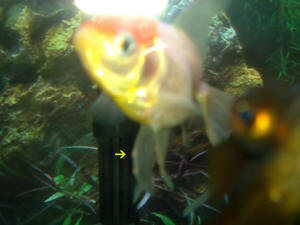
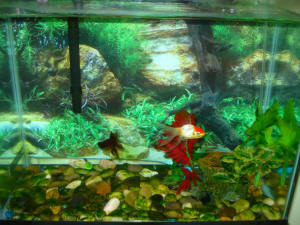
|
 |
New Print and
eBook on Amazon
Goldfish Success
What it takes to keep goldfish healthy long-term
by Robert (Bob) Fenner
|
|
Bloated Goldfish, Fluid filled blisters, not dropsy.
11/13/11
Hi,
We got this goldfish about a year ago to replace a rain barrel
fish we had been caring for a friend, but kept because it was
very nice. However, this fish never did make it anywhere near
said barrel. When we got him, he was just a thumb sized, typical
goldfish,
<A Comet variety>
who proceeded to grow rapidly as we kept him. We were not
surprised, we have a large tank and so tend to grow large
fish.
<They can/do get to over a foot in length, if kept under good
circumstances>
WE never saw any cause for concern about him, he has always been
healthy and happy. About a month ago, he started expanding
prodigiously in the lower half of his body, and now has tripled
his size and is growing fluid filled blisters on his sides and
underbelly.
<I see this/these in your excellent photographs>
I do not think that dropsy is the case,
<Dropsy, dropsical conditions is just a descriptive term...
akin to a "cold" in humans>
as he is retaining all of his scales, which are spreading out but
staying flat, except where pushed out by a blister. Apart from
some trouble navigating these do not seem to trouble him, and he
has been eating and breathing normally. We do a 60-70% change
weekly, being careful to maintain water temperature.
<Commendable>
We don't have much hope of saving him, but do you have any
idea what's causing this?
Thanks, Peter
<Mmm, well, could be a genetic predisposition... a bacterial
issue, possibly resultant from retained oocyte/gamete
production... The real question is what to do at this advanced,
late stage. Epsom salt addition might be ameliorative... but I
doubt it. Antibiotic injection, sans or w/ sensitivity testing is
also not likely to be of use. Should you be urged to humanely
destroy this specimen? See here re:
http://wetwebmedia.com/euthanasia.htm
T'were it me/mine, I'd be inclined to try the Epsom.
Cheers, Bob Fenner>
|
|
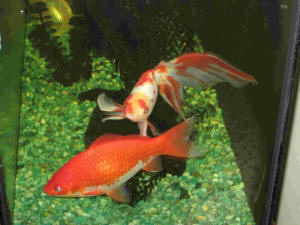 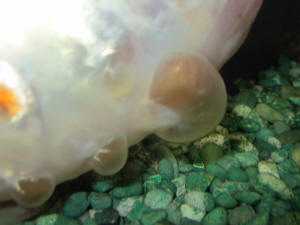
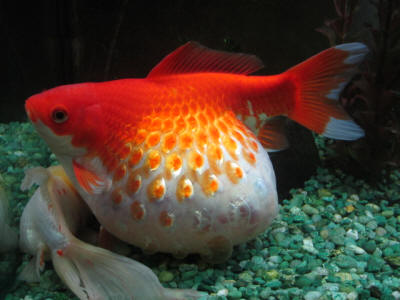
|
|
Goldfish with unexplained lump 8/27/11
Hello and thanks for the great resource!
<Hello! Glad you like the site. Merritt here>
We have a 5 year old goldfish that we bought for our son when he
was a young boy. I'm sure this is a very common scenario, but
we didn't do much homework before making the purchase. The
fish is in a 10-gallon tank, which I now know (thanks to your
great website) is quite undersized. Also, we have not maintained
a frequent enough schedule of water changes, as the latest
dipstick tests revealed Nitrates at 200, no Nitrites, a hardness
between 150-300, low alkalinity and a pH of 6.2.
<Yea, you will definitely want to do a water change and start
keeping up with the system. Thank goodness freshwater aquariums
can take abuse.>
I plan upon changing out some water immediately, and then
maintaining a more frequent schedule with a goal of keeping the
nitrate level as low as possible, and perhaps raising the pH into
the 7 range somewhere. Our fish had fin rot pretty badly at one
point a couple of years ago, but we treated him and the water and
he has bounced back nicely. Sadly, he has now developed a lump on
one side that appeared to emerge from beneath a single scale, but
has since grown to protrude about 1 cm from his body, and is
about 1cm long by 1/2 cm wide.
<Checked out the pictures and the lump appears to be a
tumor.>
Studying the WWM website for the past few days leads me to
believe that this is a tumor, but I have attached an image that
you can use to add your opinion to this diagnosis. The lump
appears well vascularized, and causes the fish no visible
distress (no scratching, swimming disruption nor eating/bowel
changes). I am hoping that the increased water quality will help
the fish to fight the tumor, but it sounds like there is little
to be done in the way of treatment otherwise.
<You are right. Hopefully the tumor will stop growing and keep
to the small size it is now. Increasing the water quality in the
tank will help with his health and it can't hurt to see if a
change occurs in the tumor.>
Please have a look and let me know what you think about our lumpy
friend. Thanks again for your time and for sharing your expertise
with us!
<As long as the tumor is not affecting his quality of life he
should be fine and live to a good ripe old age unless, the tumor
never stops growing then it will eventually kill the little guy.
Just keep an eye on it and keep up with aquarium
maintenance.>
Gail
<Merritt>
|
|
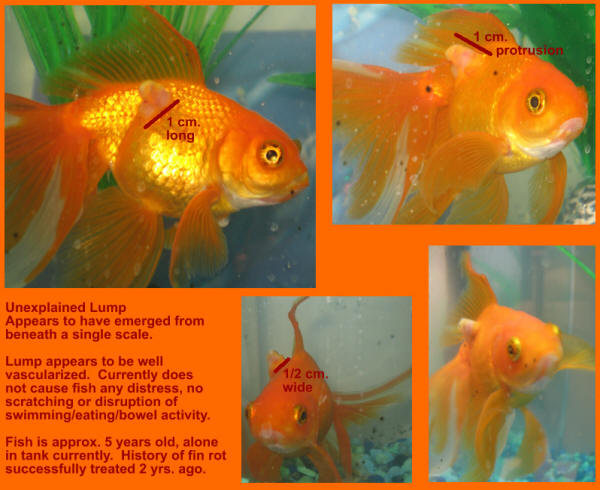
|
Big goldfish 8/4/11
Hello WWM, thanks for taking the time to read this!
I have a 12 inch common goldfish that I have had for about 8 years.
About 4 years ago it developed a black spot on it's side. I treated
it for black spot disease and it went away. However, about a year ago
in the same spot a tumor or ulcer like bump grew from
the same spot. It didn't seem to affect it's health at all, so
I thought it would just go away. Recently it has been growing and is
now about the diameter of a dime. Any clue on what it may be or how to
cure it?
Thanks, Jesse
<Hello Jesse. I don't think the tumour has anything to do with
Black Spot Disease (which is actually rather rare on aquarium fish, and
normally seen on pond fish). In any event, these sorts of tumours are
usually impossible to treat. Lymphocystis for example may clear up on
its own accord if water quality and diet are good, but internal
tumours, whether benign or cancerous, will likely be there until the
death of the fish. A vet may be able to excise a tumour from a large
fish, so you could call around any vets in your area who treat Koi and
other pond fish. Otherwise, I can't offer much by way of advice
here. Good luck, Neale.>
|
Red Cap Oranda with red nodules on
fins. 7/31/11
Hello,
<Hello!>
My name is Kelly and I have to goldfish, the Oranda and a black
moor. I got both at the same time about 6 months ago and they
have been just wonderful.
<Cool.>
They are on a diet of Tetra Fin goldfish flakes one day and 5
green English peas the next for their constipation issues and
general good diet, I've noticed from their feces that they
also snack on the green algae in their tank some.
<Yes, they will.>
There is a small amount of green algae on the rocks at the bottom
of the tank but I keep the glass clean with a brush. I do 20%
water changes to my 10 gallon tank every or every other week
using distilled water
<Would not use distilled water! Much too soft. Hard, basic tap
water, dechlorinated of course, is usually fine. If your local
water isn't suitable for fishkeeping (though if drinkable, it
should be) then you can certainly use RO water, provided that RO
water has some mineral salts added. A cheap solution is home-made
Rift Valley salt mix, at about 50% the dose recommended for
Malawian cichlids. The recipe is here:
http://www.wetwebmedia.com/fwsubwebindex/fwh2oquality.htm
>
and I have a water conditioner by API called stress coat that I
squirt a few drops of into the water maybe once a month. The tank
has a 5-10 gallon aqua tech filter on it and I change the filter
once a month. Their water temp stays at 73 which I know is a
little warm but I can't blast my ac any higher to keep them
cooler.
<Don't worry about this; 73 F is fine.>
They have a little log and a conservative amount of plants to
hang around so they still have room to swim about. I also have a
nice bubble strip in the tank for plenty of oxygen.
<Good.>
Now to the issue, today I noticed three-four small red swollen
spots along the edges of each of my Oranda's fins.
<Early stage of Finrot.>
He is still very active (much more so than my black moor who
sleeps a lot and has always done so (and no the Oranda is not
aggressive towards him) and he is eating fine. I can not find
this anywhere and have not seen any images of it and I have
searched everything! I am trying to catch this, if it is a
problem, before it progresses any further. I have spent a lot of
money on these fish because when I first got them I did not
realize how needy they were but I want to care for them properly
so I upgraded their tank, bought water conditioner, better
decorations (for hiding and reduced stress level, also silk
plants to keep their fins and eyes safe), and change the filters
more often, etc. I don't want him to get sick now! He is so
pretty. Please help!
<Two things. First, correct the water chemistry as outlined
above by doing a series of 20% water changes each day over the
next 5 days, replacing the pure distilled water with either hard
tap water or RO water with the Rift Valley salt mix. That should
result in optimal water chemistry around 10-20 degrees dH, pH
7.5-8. Secondly, medicate once you've done this water change
with Finrot medication. At this stage there isn't a rush to
medicate, so I'd fix the water chemistry first of all. Stress
from the wrong water chemistry is likely one of the reasons the
fish has Finrot. In addition, check water quality -- needs to be
zero ammonia and nitrite. If you own just one test kit, get a
nitrite test kit, and check weekly for the next couple of months.
If you don't have zero nitrite, review filtration (make sure
you're maintaining the filter properly) and check you're
not overfeeding Cheers, Neale.>
|
|
 
|
|
Re: Red Cap Oranda with red nodules on
fins. 8/7/11
I have been adding tap water that is dechlorinated with tap water
conditioner (it says it removes chlorine and chloramines) and
have changed nothing else.
<Hmm'¦ well, see if your tap water contains ammonia
and perhaps copper as well. Or, play it safe and choose a
dechlorinator that removes ammonia and copper from tap
water.>
I feed them once a day so I don't think over feeding is a
problem, they always eat all of the food either at the top or as
it floats to the bottom if the filter doesn't catch it.
<This is good, but while fish are sickly, and if you ever
detect non-zero levels of ammonia or nitrite in the aquarium,
reduce feeding substantially. Indeed, you may safely stop feeding
for several days, a week if need be, until you're sure you
have things under control.>
The red cap is still very lively and eating fine but today I
noticed a small red spot on his belly. The nodules on his
pectoral fins are no longer reddish/pinkish but just white and no
other issues with any of his other fins are visible. He and the
black moor have grown a lot since I put them in the 10 gallon and
I plan to upgrade them to a bigger tank when I can but right now
I just can not afford a 200 dollar tank and stand to put it
on,
<I understand and sympathise. Unfortunately, in small tanks,
you'll be constantly battling against disease. Goldfish just
don't do well in small tanks. You *may* be able to trade in
older fish for more youngsters at your local pet store, but
better yet would be finding a local fish club and seeing if they
can help out, either by homing safely big fish, or else providing
you with a better aquarium at minimal cost (used tanks can be a
good purchase, but obviously not if they leak, so there's an
element of trust involved that works best through fish
clubs).>
I got the one I have from a friend for much less than it would
have been in the store, I originally had them in a 5 gallon! I am
on a college budget and was uninformed when I got these fish but
I have spent a lot trying to take the best care of them I can. I
know the 10 gallon really isn't adequate but its the best I
can do for now, I do water changes often though and the water is
never cloudy and the bottom stays clean. How long will it take
for him to start healing and should I do more for him now that
the small red spot has appeared on his belly?
<For now, would simply concentrate on [a] ensuring ideal water
quality as best you can, through filtration, minimising feeding,
and more frequent water changes; and [b] medicating against
Finrot only if the spots or whatever don't get better by
themselves. Cheers, Neale.>
|
 |
New Print and
eBook on Amazon
Goldfish Success
What it takes to keep goldfish healthy long-term
by Robert (Bob) Fenner
|
|
|

